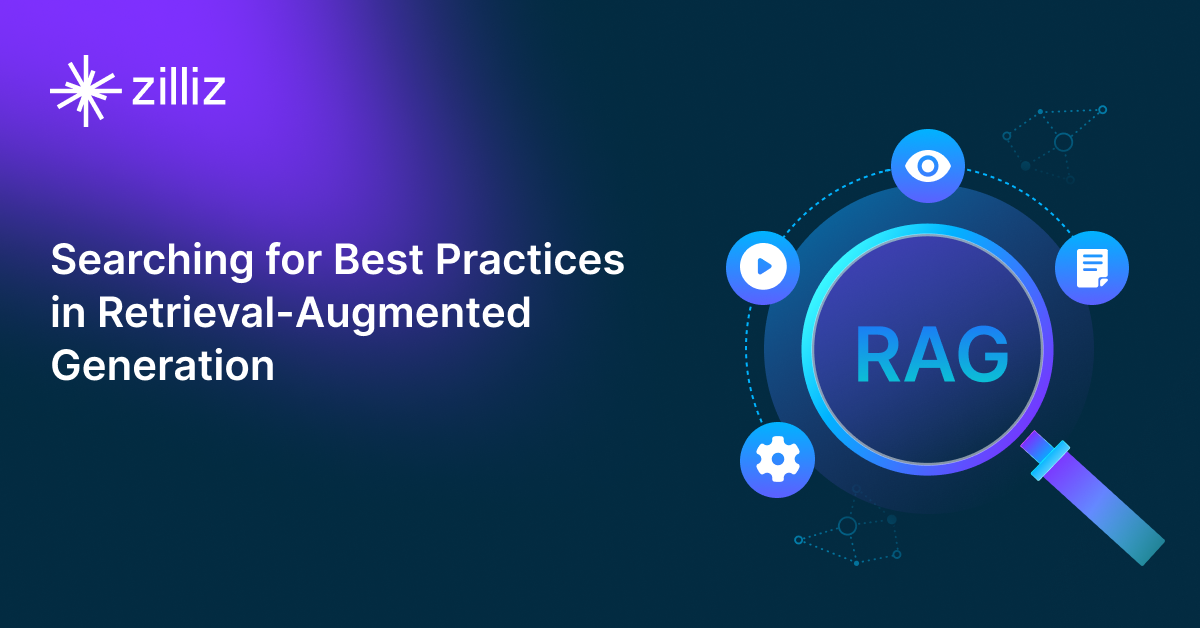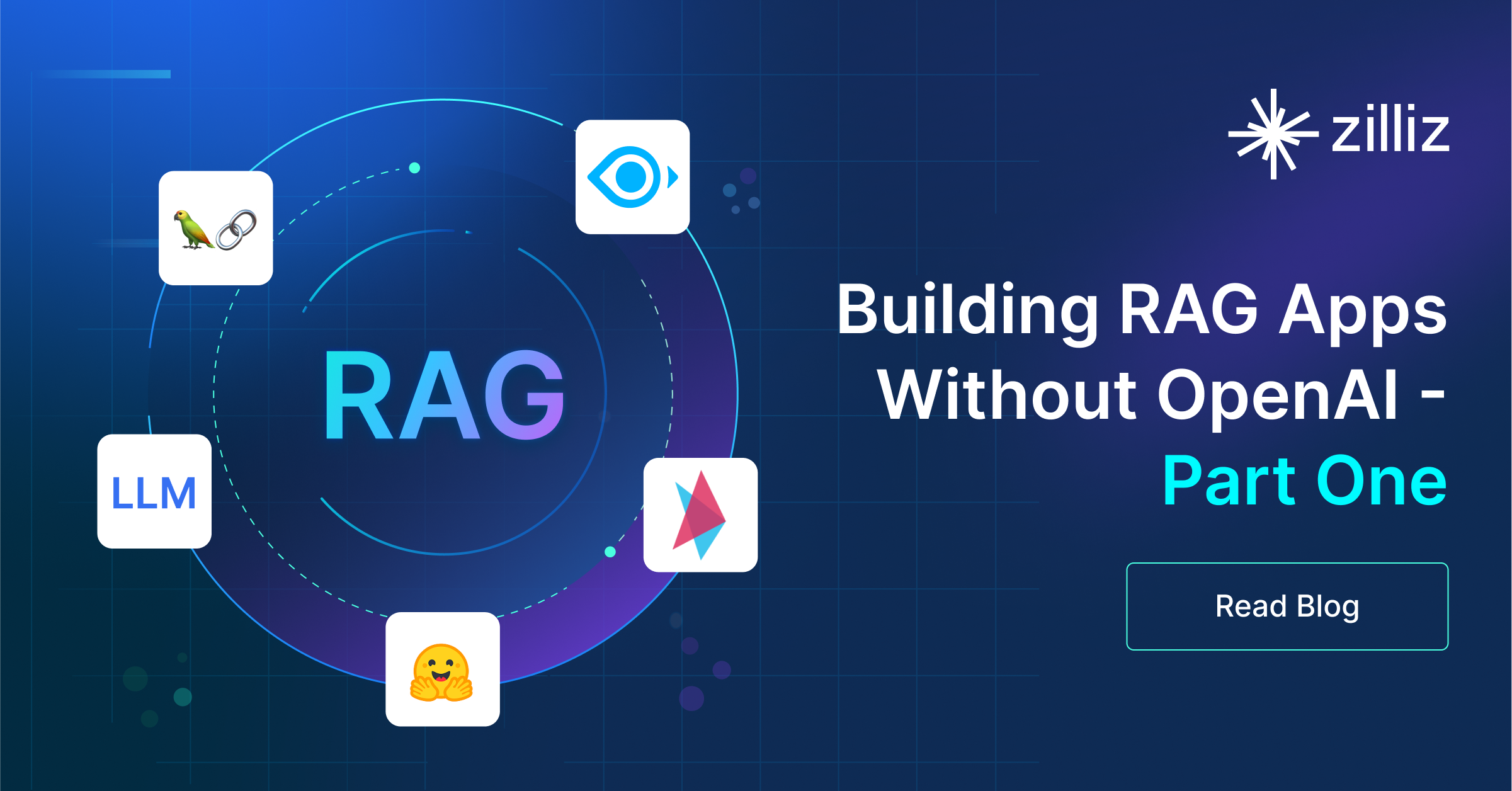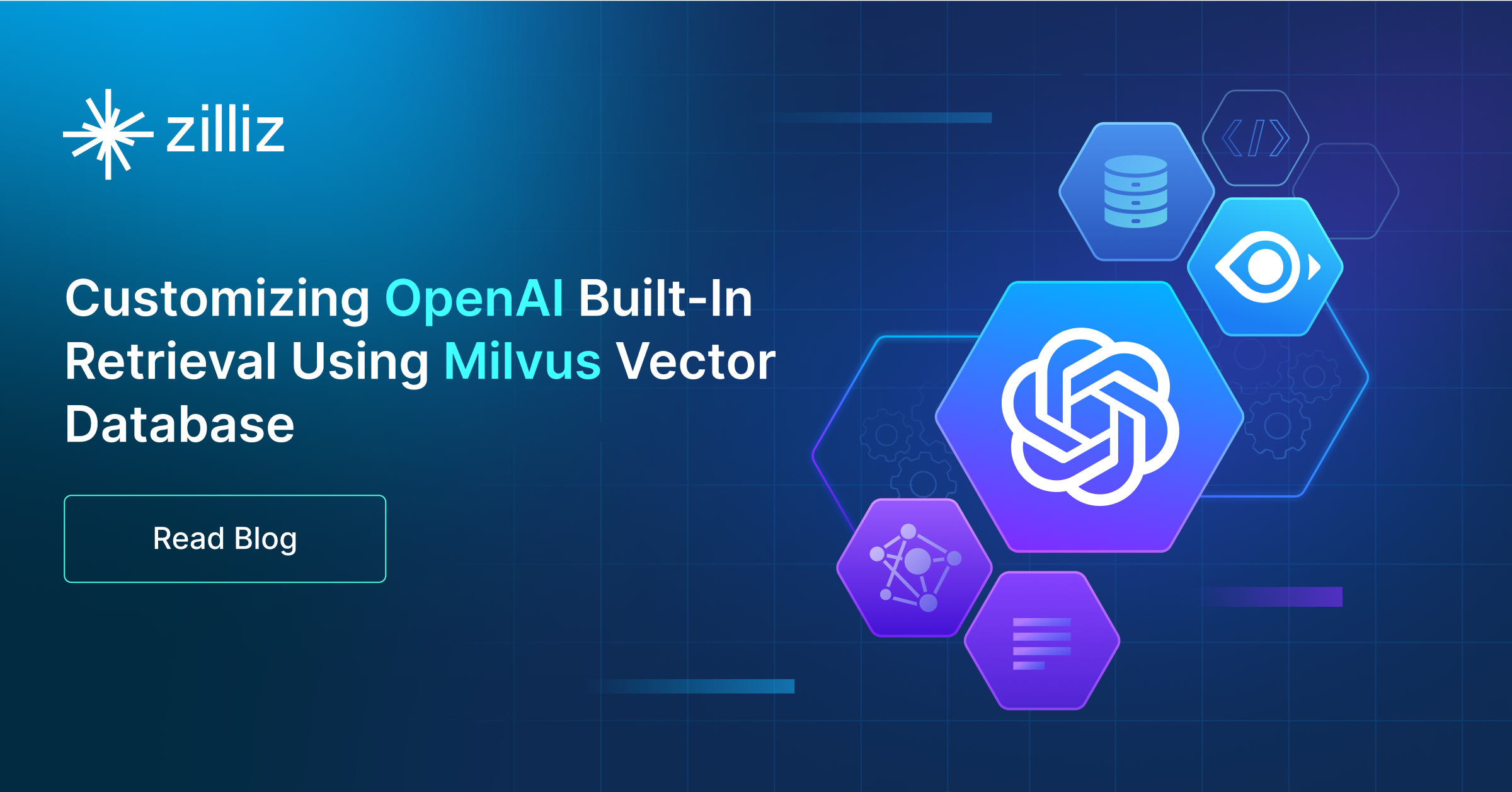Build RAG Chatbot with Haystack, Zilliz Cloud, STACKIT Meta-Llama-3.1-70B-Instruct-FP8, and OpenAI text-embedding-3-large
Introduction to RAG
Retrieval-Augmented Generation (RAG) is a game-changer for GenAI applications, especially in conversational AI. It combines the power of pre-trained large language models (LLMs) like OpenAI’s GPT with external knowledge sources stored in vector databases such as Milvus and Zilliz Cloud, allowing for more accurate, contextually relevant, and up-to-date response generation. A RAG pipeline usually consists of four basic components: a vector database, an embedding model, an LLM, and a framework.
Key Components We'll Use for This RAG Chatbot
This tutorial shows you how to build a simple RAG chatbot in Python using the following components:
- Haystack: An open-source Python framework designed for building production-ready NLP applications, particularly question answering and semantic search systems. Haystack excels at retrieving information from large document collections through its modular architecture that combines retrieval and reader components. Ideal for developers creating search applications, chatbots, and knowledge management systems that require efficient document processing and accurate information extraction from unstructured text.
- Zilliz Cloud: a fully managed vector database-as-a-service platform built on top of the open-source Milvus, designed to handle high-performance vector data processing at scale. It enables organizations to efficiently store, search, and analyze large volumes of unstructured data, such as text, images, or audio, by leveraging advanced vector search technology. It offers a free tier supporting up to 1 million vectors.
- STACKIT Meta-Llama-3.1-70B-Instruct-FP8: A 70-billion-parameter instruction-tuned AI model optimized for complex NLP tasks. Leveraging FP8 quantization, it balances high performance with efficient resource usage, excelling in understanding nuanced instructions and generating context-aware responses. Ideal for enterprise applications requiring precise, scalable solutions in chatbots, virtual assistants, data analysis, and automated content generation.
- OpenAI text-embedding-3-large: A state-of-the-art embedding model designed to convert text into high-dimensional vectors, capturing deep semantic relationships. Renowned for its accuracy, scalability, and ability to handle long contexts (up to 8192 tokens), it excels in semantic search, retrieval-augmented generation (RAG), recommendation systems, and multilingual NLP tasks requiring nuanced language understanding.
By the end of this tutorial, you’ll have a functional chatbot capable of answering questions based on a custom knowledge base.
Note: Since we may use proprietary models in our tutorials, make sure you have the required API key beforehand.
Step 1: Install and Set Up Haystack
import os
import requests
from haystack import Pipeline
from haystack.components.converters import MarkdownToDocument
from haystack.components.preprocessors import DocumentSplitter
from haystack.components.writers import DocumentWriter
Step 2: Install and Set Up STACKIT Meta-Llama-3.1-70B-Instruct-FP8
STACKIT is the cloud and colocation provider of the Schwarz Group. We can use different models on its cloud services with ease through its API.
pip install stackit-haystack
from haystack_integrations.components.generators.stackit import STACKITChatGenerator
from haystack.dataclasses import ChatMessage
generator = STACKITChatGenerator(model="neuralmagic/Meta-Llama-3.1-70B-Instruct-FP8")
Step 3: Install and Set Up OpenAI text-embedding-3-large
Text documents often come with a set of metadata. If they are distinctive and semantically meaningful, you can embed them along with the text of the document to improve retrieval.
from haystack import Document
from haystack.components.embedders import OpenAIDocumentEmbedder
doc = Document(content="some text",meta={"title": "relevant title", "page number": 18})
document_embedder = OpenAIDocumentEmbedder(meta_fields_to_embed=["title"])
docs_w_embeddings = embedder.run(documents=[doc])["documents"]
Now let's install and set up the model.
from haystack import Document
from haystack.components.embedders import OpenAIDocumentEmbedder
from haystack.components.embedders import OpenAITextEmbedder
text_embedder = OpenAITextEmbedder(api_key=Secret.from_token("<your-api-key>"), model="text-embedding-3-large")
document_embedder = OpenAIDocumentEmbedder(api_key=Secret.from_token("<your-api-key>"), model="text-embedding-3-large")
Step 4: Install and Set Up Zilliz Cloud
pip install --upgrade pymilvus milvus-haystack
from milvus_haystack import MilvusDocumentStore
from milvus_haystack.milvus_embedding_retriever import MilvusEmbeddingRetriever
document_store = MilvusDocumentStore(connection_args={"uri": ZILLIZ_CLOUD_URI, "token": ZILLIZ_CLOUD_TOKEN}, drop_old=True,)
retriever = MilvusEmbeddingRetriever(document_store=document_store, top_k=3)
Step 5: Build a RAG Chatbot
Now that you’ve set up all components, let’s start to build a simple chatbot. We’ll use the Milvus introduction doc as a private knowledge base. You can replace it your own dataset to customize your RAG chatbot.
url = 'https://raw.githubusercontent.com/milvus-io/milvus-docs/refs/heads/v2.5.x/site/en/about/overview.md'
example_file = 'example_file.md'
response = requests.get(url)
with open(example_file, 'wb') as f:
f.write(response.content)
file_paths = [example_file] # You can replace it with your own file paths.
indexing_pipeline = Pipeline()
indexing_pipeline.add_component("converter", MarkdownToDocument())
indexing_pipeline.add_component("splitter", DocumentSplitter(split_by="sentence", split_length=2))
indexing_pipeline.add_component("embedder", document_embedder)
indexing_pipeline.add_component("writer", DocumentWriter(document_store))
indexing_pipeline.connect("converter", "splitter")
indexing_pipeline.connect("splitter", "embedder")
indexing_pipeline.connect("embedder", "writer")
indexing_pipeline.run({"converter": {"sources": file_paths}})
# print("Number of documents:", document_store.count_documents())
question = "What is Milvus?" # You can replace it with your own question.
retrieval_pipeline = Pipeline()
retrieval_pipeline.add_component("embedder", text_embedder)
retrieval_pipeline.add_component("retriever", retriever)
retrieval_pipeline.connect("embedder", "retriever")
retrieval_results = retrieval_pipeline.run({"embedder": {"text": question}})
# for doc in retrieval_results["retriever"]["documents"]:
# print(doc.content)
# print("-" * 10)
from haystack.utils import Secret
from haystack.components.builders import PromptBuilder
retriever = MilvusEmbeddingRetriever(document_store=document_store, top_k=3)
text_embedder = OpenAITextEmbedder(api_key=Secret.from_token("<your-api-key>"), model="text-embedding-3-large")
prompt_template = """Answer the following query based on the provided context. If the context does
not include an answer, reply with 'I don't know'.\n
Query: {{query}}
Documents:
{% for doc in documents %}
{{ doc.content }}
{% endfor %}
Answer:
"""
rag_pipeline = Pipeline()
rag_pipeline.add_component("text_embedder", text_embedder)
rag_pipeline.add_component("retriever", retriever)
rag_pipeline.add_component("prompt_builder", PromptBuilder(template=prompt_template))
rag_pipeline.add_component("generator", generator)
rag_pipeline.connect("text_embedder.embedding", "retriever.query_embedding")
rag_pipeline.connect("retriever.documents", "prompt_builder.documents")
rag_pipeline.connect("prompt_builder", "generator")
results = rag_pipeline.run({"text_embedder": {"text": question}, "prompt_builder": {"query": question},})
print('RAG answer:\n', results["generator"]["replies"][0])
Optimization Tips
As you build your RAG system, optimization is key to ensuring peak performance and efficiency. While setting up the components is an essential first step, fine-tuning each one will help you create a solution that works even better and scales seamlessly. In this section, we’ll share some practical tips for optimizing all these components, giving you the edge to build smarter, faster, and more responsive RAG applications.
Haystack optimization tips
To optimize Haystack in a RAG setup, ensure you use an efficient retriever like FAISS or Milvus for scalable and fast similarity searches. Fine-tune your document store settings, such as indexing strategies and storage backends, to balance speed and accuracy. Use batch processing for embedding generation to reduce latency and optimize API calls. Leverage Haystack's pipeline caching to avoid redundant computations, especially for frequently queried documents. Tune your reader model by selecting a lightweight yet accurate transformer-based model like DistilBERT to speed up response times. Implement query rewriting or filtering techniques to enhance retrieval quality, ensuring the most relevant documents are retrieved for generation. Finally, monitor system performance with Haystack’s built-in evaluation tools to iteratively refine your setup based on real-world query performance.
Zilliz Cloud optimization tips
Optimizing Zilliz Cloud for a RAG system involves efficient index selection, query tuning, and resource management. Use Hierarchical Navigable Small World (HNSW) indexing for high-speed, approximate nearest neighbor search while balancing recall and efficiency. Fine-tune ef_construction and M parameters based on your dataset size and query workload to optimize search accuracy and latency. Enable dynamic scaling to handle fluctuating workloads efficiently, ensuring smooth performance under varying query loads. Implement data partitioning to improve retrieval speed by grouping related data, reducing unnecessary comparisons. Regularly update and optimize embeddings to keep results relevant, particularly when dealing with evolving datasets. Use hybrid search techniques, such as combining vector and keyword search, to improve response quality. Monitor system metrics in Zilliz Cloud’s dashboard and adjust configurations accordingly to maintain low-latency, high-throughput performance.
STACKIT Meta-Llama-3.1-70B-Instruct-FP8 optimization tips
To optimize STACKIT Meta-Llama-3.1-70B-Instruct-FP8 in RAG, prioritize reducing input token length by truncating or summarizing retrieved documents to fit the model’s context window. Use FP8 precision to accelerate inference while maintaining accuracy. Batch processing for parallel queries improves throughput. Cache frequent or repetitive queries to avoid redundant computations. Fine-tune retrieval thresholds to balance relevance and noise. Leverage hardware-specific optimizations (e.g., Tensor Cores on GPUs) and enable model parallelism for distributed workloads. Monitor memory usage to prevent bottlenecks, and prune low-confidence outputs early to save resources.
OpenAI text-embedding-3-large optimization tips
Optimize OpenAI text-embedding-3-large in RAG by adjusting the dimensions parameter to balance accuracy and efficiency—lower values reduce latency and cost while retaining semantic relevance. Batch embedding requests to maximize throughput, preprocess text to remove noise (e.g., truncate to 8191 tokens, normalize whitespace), and cache frequent queries. Use cosine similarity for retrieval alignment, validate embeddings with domain-specific benchmarks, and fine-tune hybrid search strategies (e.g., combining sparse/dense vectors) to improve recall. Monitor API rate limits and leverage asynchronous calls for scalability.
By implementing these tips across your components, you'll be able to enhance the performance and functionality of your RAG system, ensuring it’s optimized for both speed and accuracy. Keep testing, iterating, and refining your setup to stay ahead in the ever-evolving world of AI development.
RAG Cost Calculator: A Free Tool to Calculate Your Cost in Seconds
Estimating the cost of a Retrieval-Augmented Generation (RAG) pipeline involves analyzing expenses across vector storage, compute resources, and API usage. Key cost drivers include vector database queries, embedding generation, and LLM inference.
RAG Cost Calculator is a free tool that quickly estimates the cost of building a RAG pipeline, including chunking, embedding, vector storage/search, and LLM generation. It also helps you identify cost-saving opportunities and achieve up to 10x cost reduction on vector databases with the serverless option.
 Calculate your RAG cost
Calculate your RAG cost
What Have You Learned?
By diving into this tutorial, you’ve unlocked the power of building a modern RAG system from the ground up! You’ve seen how Haystack acts as the glue, seamlessly connecting your framework to orchestrate workflows, while Zilliz Cloud steps in as the high-performance vector database, storing and retrieving embeddings at lightning speed. Pairing these with STACKIT Meta-Llama-3-70B-Instruct-FP8, a powerhouse LLM optimized for precision and efficiency, and OpenAI’s text-embedding-3-large, which transforms text into rich, context-aware vectors, you’ve learned how each component plays a distinct role. The tutorial walked you through embedding your data, indexing it for quick access, and generating human-like responses—all while balancing speed, accuracy, and scalability. Plus, you picked up pro tips like tuning chunk sizes for better performance and using the free RAG cost calculator to estimate expenses, ensuring your projects stay budget-friendly and cutting-edge.
Now that you’ve seen the magic of integrating frameworks, databases, models, and embeddings, the real adventure begins! Whether you’re enhancing customer support bots, building personalized recommendation engines, or tackling entirely new use cases, you’ve got the tools to innovate. Remember, every line of code you write brings you closer to solving real-world problems with AI. So fire up your IDE, experiment with optimizations, and let your creativity run wild. The future of intelligent applications is in your hands—go build something amazing, share your wins, and keep pushing the boundaries of what RAG can do. The possibilities? They’re endless, and you’re ready to conquer them. 🚀
Further Resources
🌟 In addition to this RAG tutorial, unleash your full potential with these incredible resources to level up your RAG skills.
- How to Build a Multimodal RAG | Documentation
- How to Enhance the Performance of Your RAG Pipeline
- Graph RAG with Milvus | Documentation
- How to Evaluate RAG Applications - Zilliz Learn
- Generative AI Resource Hub | Zilliz
We'd Love to Hear What You Think!
We’d love to hear your thoughts! 🌟 Leave your questions or comments below or join our vibrant Milvus Discord community to share your experiences, ask questions, or connect with thousands of AI enthusiasts. Your journey matters to us!
If you like this tutorial, show your support by giving our Milvus GitHub repo a star ⭐—it means the world to us and inspires us to keep creating! 💖
- Introduction to RAG
- Key Components We'll Use for This RAG Chatbot
- Step 1: Install and Set Up Haystack
- Step 2: Install and Set Up STACKIT Meta-Llama-3.1-70B-Instruct-FP8
- Step 3: Install and Set Up OpenAI text-embedding-3-large
- Step 4: Install and Set Up Zilliz Cloud
- Step 5: Build a RAG Chatbot
- Optimization Tips
- RAG Cost Calculator: A Free Tool to Calculate Your Cost in Seconds
- What Have You Learned?
- Further Resources
- We'd Love to Hear What You Think!
Content
Vector Database at Scale
Zilliz Cloud is a fully-managed vector database built for scale, perfect for your RAG apps.
Try Zilliz Cloud for Free


